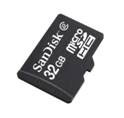 Well, of course the official Xbox 360 USB stick from SanDisk is outrageously priced, at $35 for 8 GB and $70 for 16 GB. That’s roughly double what you’d pay for comparable SanDisk drives, sans Xbox branding.
Well, of course the official Xbox 360 USB stick from SanDisk is outrageously priced, at $35 for 8 GB and $70 for 16 GB. That’s roughly double what you’d pay for comparable SanDisk drives, sans Xbox branding.
Microsoft started allowing external storage on the Xbox 360 last month. Although any flash drive or hard drive will do, Microsoft promised its own solution was forthcoming, and pretty much everyone assumed correctly that it wouldn’t be cheap.
In exchange for the hefty markup, you get a month of Xbox Live Gold (an $8 value) and plug-and-play support, which means you don’t have to format the drive using the console’s interface. I’d take the money.
But don’t blame Microsoft for thinking its brand name commands a premium. This is an industry tradition that predates the current console generation.
For instance, NewEgg sells a two-pack of 8 MB memory cards for the Playstation 2 for $34. A single, $30 card from Intec holds four times the data of both official cards combined. When I was in high school, I remember getting a similar deal on Nintendo 64 memory, with a third-party memory pack that cost roughly the same as the official model, but with four times the capacity.
Console makers aren’t the only ones who charge more than they should for storage. A 4 GB SanDisk Memory Stick Pro Duo for the PSP costs $35 at GameStop. The same exact product is $24 on Amazon and $19 on NewEgg. GameStop also plans to charge an extra $5 for the 8 GB Xbox 360 USB stick.
If you’re reading this blog, I have a feeling you’re tech-savvy enough to shop around and avoid the games industry’s storage shenanigans. Microsoft did good by allowing non-proprietary memory on the Xbox 360, but the availability of cheap USB sticks highlights the silliness of charging high premiums for branding.
 SanDisk is introducing a new MP3 player today. It’s called the Sansa Zip Clip, sells for under $50, and has a 1.1″ color screen, 4GB of storage, a MicroSD slot, a stopwatch, and an FM radio. Until the company alerted me to the news, I’d sort of forgotten that anyone was releasing new stand-alone MP3 players. But hearing about it got me thinking about a newer market dominated by Apple–tablets.
SanDisk is introducing a new MP3 player today. It’s called the Sansa Zip Clip, sells for under $50, and has a 1.1″ color screen, 4GB of storage, a MicroSD slot, a stopwatch, and an FM radio. Until the company alerted me to the news, I’d sort of forgotten that anyone was releasing new stand-alone MP3 players. But hearing about it got me thinking about a newer market dominated by Apple–tablets.

 More CTIA news: SanDisk has announced that it’s
More CTIA news: SanDisk has announced that it’s  Calm before the E3 storm…
Calm before the E3 storm… I still run hot and cold on the prospects for Google’s Android OS. With this week’s launch of the T-Mobile G1, though, I’m feeling fairly upbeat about it. For now, at least…
I still run hot and cold on the prospects for Google’s Android OS. With this week’s launch of the T-Mobile G1, though, I’m feeling fairly upbeat about it. For now, at least…  Music is about to get microscopic. Flash storage kingpin SanDisk is launching
Music is about to get microscopic. Flash storage kingpin SanDisk is launching